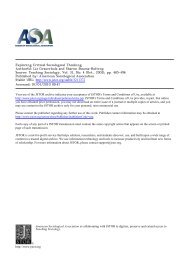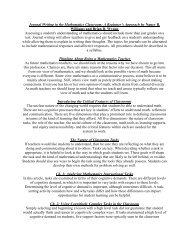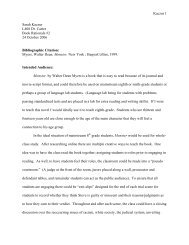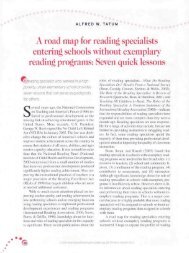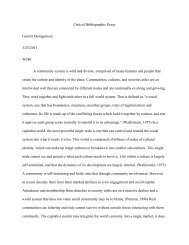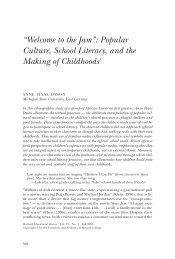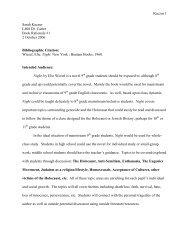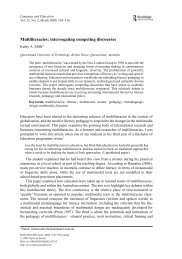Rose 2005 Pragmatics Synthesis.pdf - Oncourse
Rose 2005 Pragmatics Synthesis.pdf - Oncourse
Rose 2005 Pragmatics Synthesis.pdf - Oncourse
Create successful ePaper yourself
Turn your PDF publications into a flip-book with our unique Google optimized e-Paper software.
390 K.R. <strong>Rose</strong> / System 33 (<strong>2005</strong>) 385–399<br />
4. Research issues and findings<br />
Studies on the effect of instruction in pragmatics seek to answer three basic questions:<br />
first, is the targeted pragmatic feature teachable at all Second, is instruction in<br />
the targeted feature more effective than no instruction And third, are different teaching<br />
approaches differentially effective The first question, whether pragmatics are<br />
amenable to instruction at all, is the most basic of the three questions, representing<br />
at best a starting point analogous to LongÕs (1983) early survey of instructed second<br />
language acquisition research which attempted to answer the question Does second<br />
language instruction make a difference Question two – the comparison of the relative<br />
merits of instruction versus simple exposure – echoes Norris and OrtegaÕs (2000) first<br />
research question, reflecting the fact that this is the point where things begin to get<br />
more interesting. Knowing whether a given feature is teachable is one thing, but<br />
knowing whether instruction is more effective than exposure is another. The third<br />
question further specifies the issue by addressing the differential effects of more than<br />
one type of instructional intervention. Studies which fall into the third category are<br />
likely to yield information that is most relevant for pedagogical purposes.<br />
4.1. Teachability<br />
The most basic question that studies on the effect of instruction in pragmatics may<br />
consider is whether a particular area of pragmatics is at all teachable. Such studies<br />
typically adopt a one-group pretest–posttest design. Olshtain and Cohen (1990)<br />
chose as their learning target the more subtle aspects of apologizing, such as the differences<br />
between excuse me and IÕm sorry, and the effects of context on the choice of<br />
intensifiers. LoCastroÕs (1997) pedagogical intervention dealt with politeness strategies<br />
in group discussion, such as requesting answers, directing the talk, and seeking<br />
(dis)agreement, whereas Liddicoat and Crozet (2001) set out to teach appropriately<br />
elaborated responses to the French question TÕas passé un bon week-end (Did you<br />
have a good weekend). Two studies done with university students learning English<br />
in Spain by Safont (2003) and Salazar (2003) both dealt with the effects of instruction<br />
on requests, with the former focusing on the use of internal and external modification.<br />
In these studies, treatment lengths varied from a minimum of two (Salazar,<br />
2003) or three (Olshtain and Cohen, 1990) 20-min sessions to a maximum of instruction<br />
spread out over a 9-week period (LoCastro, 1997). Assessment measures also<br />
varied considerably, from written DCTs (Olshtain and Cohen, 1990; Safont, 2003;<br />
Salazar, 2003) to role-plays (Liddicoat and Crozet, 2001) and observations of small<br />
group interaction (LoCastro, 1997). The type of instruction adopted in these studies<br />
could be characterized as explicit, which, according to DeKeyser (1995), requires<br />
that metalinguistic generalization be part of the instruction, whether it is provided<br />
by the teacher or the learners themselves. Results provided by teachability studies<br />
have been mixed. LoCastro (1997) found no change after 9 weeks of instruction –<br />
participants continued to rely on bare head acts at the time of the posttest. Olshtain<br />
and CohenÕs (1990) participants did not benefit from instruction in terms of overall<br />
frequency of semantic formulas used, but posttest responses did contain a wider



